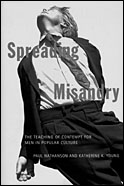Popular culture's war on men
Misogyny is an attitude that nobody in his or her right mind would seek to defend, and popular culture takes a misogynist stance at its own peril.
 |
|
Not so, misandry. It is perfectly acceptable -- indeed, common -- to portray men in misandric terms as violent, vulgar, insensitive boors, argue Paul Nathanson and Katherine Young in their provocative new book, Spreading Misandry: The Teaching of Contempt for Men in Popular Culture (McGill-Queen's University Press).
Their research, which will eventually fill three volumes, is the result of 15 years of discussions between them about gender and its complex role in society and inter-sexual relations.
"We began to see a pattern emerging," asserts Young, a religious studies professor. "And we were surprised at the extent of the misandry depicted. That, and the fact that there was absolutely no critique of it whatsoever. It just isn't taken seriously."
They write, "Misandry has become so embedded in our culture that few people -- including men -- even recognize it." Furthermore, "these problems should sound very familiar. Precisely the same ones arose 30 years ago, in connection with discussions of women as portrayed in popular culture." In other words, there's a backlash in evidence. Ideological feminism, they argue, has twisted its disgust at the negative portrayals of women that were the norm 30 years ago into a derisive outlook on men.
"It's part of a formula in our culture that women are victims, which leaves men to be portrayed as victimizers," according to Nathanson, who has earned four degrees at McGill, including a PhD in religious studies. "It's an ideological approach that insists that evil originates with "them." This "them" changes over the course of time, but it is always some recognizable other, whether of a different race, nationality, or gender."
Because misandry goes unchallenged, men make for a safe source of evil, one that is unlikely to cause the purveyors of pop culture any trouble by offending a segment of their market.
"Largely, it comes down to money," Nathanson goes on. "The executives who decide which movies or television shows are to be produced intuit what is acceptable by gauging what people will pay to see." And nobody objects to watching villainous men behaving badly.
Adds Young, "Popular culture both generates and reflects our attitudes, though we're not entirely sure in which order." In other words, they haven't determined whether misandry is acceptable because we see it in so many male characters or if we see so many misandric characters because it's acceptable.
Just as Susan Faludi's bestseller Backlash: The Undeclared War Against American Women outlined the subtle and not-so-subtle misogyny she glimpsed in films such as Fatal Attraction, Young and Nathanson pick apart the way men are portrayed in such movies as Cape Fear, Sleeping With the Enemy and What Planet Are You From? An appendix to the book, called "The Misandric Week on Television," lists several TV shows and films that feature male characters as murderers, rapists, sexual harassers and/or stalkers. Or, in the case of a TV show like Home Improvement, a bumbling macho goof.
Spreading Misandry catalogues the extent of this phenomenon in films, television, comic strips, even greeting cards -- to the point where it's become blithely accepted and nobody feels slighted by Archie Bunker or Homer Simpson or Dagwood Bumstead. In these three cases, the male character is, respectively, a bigot, an ignoramus, and a lay-about. As well, all are attended by a sweet, long-suffering, tolerant and, ultimately, wise wife. Each, Young and Nathanson would contend, represents a misandric attitude toward men. The common response is simply not to take what they represent as threatening.
"That's wrong," Nathanson responds forcefully. "It becomes a fundamental question of identity for boys. Our sense of identity is formed in the context of what distinctive contribution we make to society. If all a boy sees are negative images associated with men, he's left with choosing a negative identity or no identity at all."
Before one moves to dismiss that argument, be reminded that the absence of positive representations of women was among the objections of ideological feminists of an earlier era. The effects can be profound, as children come to believe their options and behaviour to be cast within the limits of what they see in the entertainment to which they are exposed.
In calling attention to misandry Young and Nathanson know they are daring to challenge conventional thoughts that say men are a privileged class and therefore immune to victimization.
"There's no excuse for negative stereotyping of any kind," insists Young. "What we've presented is the truth and we're just asking that it be examined objectively."
Their aim, they say, is to foster a dialogue between the sexes through which we can learn more about one another. The book, says Nathanson, is an "act of understanding." Perhaps, if misandry can be recognized on the same plane as misogyny, they can both be eliminated and the sexes can relate to each other without resorting to negativity.
The forthcoming volumes of the trilogy will deal with the theories that underlie the creation of misandry and how this thinking has infiltrated the institutions and professional networks of society. They will illustrate that the issue is not just one of pop culture, but extends throughout our culture and how men and women have been conditioned to perceive themselves and one another.

